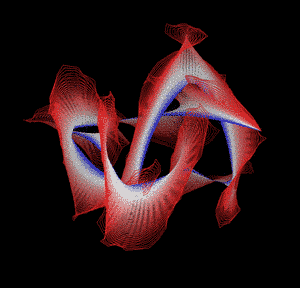Knotted protein
Knotted proteins are a fascinating class of proteins that possess a unique structural feature: their polypeptide chains are arranged in a manner that forms a physical knot. This intriguing characteristic has drawn significant attention from the biochemistry, molecular biology, and biophysics communities, as it challenges traditional views on protein folding and stability. The study of knotted proteins not only provides insights into the complexity of protein structure and folding mechanisms but also has implications for understanding diseases related to protein misfolding and the development of novel biotechnological applications.
Overview[edit | edit source]
Knotted proteins defy the once widely held belief that protein chains fold into the simplest, most energy-efficient structures. The presence of knots in proteins suggests a more complex landscape of protein folding and function. The knots found in these proteins are categorized based on their complexity, from simple trefoil knots to more complex figures such as penta- and hexa-knots. The determination of these structures is primarily achieved through X-ray crystallography and nuclear magnetic resonance (NMR) spectroscopy, which have revealed the precise nature of these knots and their locations within the protein structures.
Biological Significance[edit | edit source]
The biological significance of knotted proteins is still a subject of research. It is hypothesized that the knotted configuration may contribute to the stability of the protein, protect critical active sites, and influence the protein's functional dynamics. For example, some enzymes with knotted structures have been shown to possess unique catalytic properties that are believed to be related to their knotted conformation. Moreover, the process of knotting and unknotting has been suggested to play a role in the regulation of protein activity and function.
Examples[edit | edit source]
One of the most well-studied knotted proteins is methyltransferase, which contains a trefoil knot. This enzyme is involved in the modification of the chemical structure of RNA and DNA, impacting gene expression and regulation. Another example is carbonic anhydrase, a knotted protein that plays a crucial role in maintaining acid-base balance in blood and other tissues.
Challenges in Study[edit | edit source]
The study of knotted proteins presents several challenges. The intricate nature of their structures makes them difficult to simulate and study using conventional computational models. Additionally, understanding how these knots form during the protein folding process and their impact on protein function requires sophisticated experimental techniques and theoretical approaches.
Implications for Biotechnology[edit | edit source]
Knotted proteins hold potential for various biotechnological applications. By mimicking or modifying the unique properties of knotted proteins, researchers aim to design novel enzymes with enhanced stability and catalytic efficiency. Furthermore, the study of protein knots may contribute to the development of new strategies for preventing or treating diseases associated with protein misfolding.
Conclusion[edit | edit source]
Knotted proteins represent a remarkable and complex area of study in molecular biology and biochemistry. Their existence challenges traditional notions of protein folding and opens up new avenues for research into protein structure and function. As our understanding of these proteins grows, so too does the potential for innovative applications in medicine and biotechnology.
Search WikiMD
Ad.Tired of being Overweight? Try W8MD's physician weight loss program.
Semaglutide (Ozempic / Wegovy and Tirzepatide (Mounjaro / Zepbound) available.
Advertise on WikiMD
|
WikiMD's Wellness Encyclopedia |
| Let Food Be Thy Medicine Medicine Thy Food - Hippocrates |
Translate this page: - East Asian
中文,
日本,
한국어,
South Asian
हिन्दी,
தமிழ்,
తెలుగు,
Urdu,
ಕನ್ನಡ,
Southeast Asian
Indonesian,
Vietnamese,
Thai,
မြန်မာဘာသာ,
বাংলা
European
español,
Deutsch,
français,
Greek,
português do Brasil,
polski,
română,
русский,
Nederlands,
norsk,
svenska,
suomi,
Italian
Middle Eastern & African
عربى,
Turkish,
Persian,
Hebrew,
Afrikaans,
isiZulu,
Kiswahili,
Other
Bulgarian,
Hungarian,
Czech,
Swedish,
മലയാളം,
मराठी,
ਪੰਜਾਬੀ,
ગુજરાતી,
Portuguese,
Ukrainian
Medical Disclaimer: WikiMD is not a substitute for professional medical advice. The information on WikiMD is provided as an information resource only, may be incorrect, outdated or misleading, and is not to be used or relied on for any diagnostic or treatment purposes. Please consult your health care provider before making any healthcare decisions or for guidance about a specific medical condition. WikiMD expressly disclaims responsibility, and shall have no liability, for any damages, loss, injury, or liability whatsoever suffered as a result of your reliance on the information contained in this site. By visiting this site you agree to the foregoing terms and conditions, which may from time to time be changed or supplemented by WikiMD. If you do not agree to the foregoing terms and conditions, you should not enter or use this site. See full disclaimer.
Credits:Most images are courtesy of Wikimedia commons, and templates, categories Wikipedia, licensed under CC BY SA or similar.
Contributors: Prab R. Tumpati, MD




